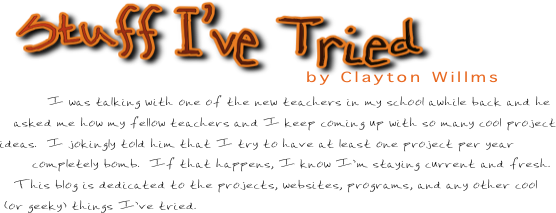
I've always loved watching animations. From old school loony toones to the newest rendered films like WALL-E to those National Film Board shorts (remember 'The Log Driver's Waltz' and 'The Cat Came Back?')on television. So I know why I was so excited when I saw yesterday's MacUpdate Promo. It was for Toon Boom Studio, a professional animation program that is regarded by many as the best of the best. The price is definitely a hint to the fact that it's a great program. Most applications that come through MacUpdate are $7.95 or $10.95 after the 50% off sale; prices I can handle with minimal resistance from the spousal front. ToonBoom's 50% off price is $199. This purchase would be an instant World War III.
So it's a good thing, I suppose, that drawing has never been my strong point. It has never come naturally to me as so many other things do. My artist friends keep telling me that I'm drawing with my mind instead of my eye. "Draw what you see," they say, "You're
 drawing what you think it should look like, instead of what it actually looks like." But I rarely get anything that doesn't look like something a small child created.
drawing what you think it should look like, instead of what it actually looks like." But I rarely get anything that doesn't look like something a small child created.There is still a hint of purchase temptation towards Toon Boom way back in the attic of my mind. That relic of a dusty trunk sits in the corner with it's brass hinges, leather strapping, and a stamped plate on the front that says, "Application Lust." I haven't opened it in so long. Sites like www.freemacware.com and www.coolosxapps.net have helped me stay away. But the trunk still sits there, confident in the knowledge that it's hinges will squeak open again sometime in the future.
Seeing Toon Boom for sale reminded me of a project I worked on with my students this year. It involved a beta program I had installed in our computer lab a few years ago called FrameByFrame. The program has now had a number of revisions and is quite amazing, especially considering it's freeware. It allows you to create stop motion animations in an easy to use and intuitive environment. If you are a mac user, I encourage you to download the app and just play with it. There are some fun things you can do in a very short period of time.
As many of you know, I've been teaching music over the past few years in our school's art rotations. I enjoy it but greatly miss my original arts course, "Digital Arts." That's another entry for another day, though. I have really wanted to do a digital arts project that involved music so I could get back into the computer lab. I love the concept behind stop-motion video and never cease looking for cool new examples of the art. Below are links to my current favourites.
FrameByFrame gave me the inspiration to build the following project. It is aimed at middle school level students but could be easily modified to older age groups. If you are a fellow educator, please feel free to download and modify the project to meet your needs.
Download the Project File - PDF
Rubric - MS Excel
The challenge was to create a one minute stop-motion animation film that expresses a concept the student has learned in one of the core subject areas (Humanities, Math, Science, or Health and Career Education). The following steps were taken to work through the project (a more detailed breakdown is in the actual project file):
- Introduce and Play with FrameByFrame. Learn the ins and outs.
- Look at many different examples of stop-motion video.
- Plan and Storyboard the movie. What's the concept? How will you lay it all out?
- Create the set. Use a shoebox or similar box to create the set for the film.
- Shoot the film. Use district borrowed, school, and individual digital cameras to create required number of frames for the film.
- Import into FrameByFrame. Adjust frames and fps. Export as Quicktime movie.
- Import into iMovie for titles & transitions. Send to Garageband.
- Use Garageband 3 (or higher) to create a movie score.
- Export final cut and hand in to teacher.
As this was the first time I've done this kind of project, some serious reflection is required. There are a number of things that I will change the next time that I tackle something like this but there were a number of great successes as well. The list below should help you if you choose to take this on -- beware the pitfalls. I hope you see the same success as I did with the project.
What Worked:
- Understanding Stop Motion. Overall, students were successful at gaining a basic understanding of how to create stop-motion video. They learned how to calculate how many frames were needed at certain frame rates to create a specific length of film (60 sec x 15 fps = 900 frames to be taken). They also learned how different frames per second settings produces a different look to their film AND related this to how we are 'tricked' into seeing motion when a series of still images flow by at a fast rate.
- The Chosen Core Concept. Most students were able to create a film that showed their knowledge of some part of their core curriculum. A number of grade sevens chose some sort of egyptian theme (pyramid building, Icis and Ra, farming). Grade sixes focused a lot on Japan (samurai, earthquakes & housing, farming) and many others chose something from Health and Career Education (anti-smoking or anti-bullying). The concepts were, for the most part, represented with a measure of success. The viewer understood what the concept was and why it's important.
- Learning Patience. Students definitely learned that stop-motion video is a meticulous art that requires a high degree of patience. This was the downfall for a number of students who just could not get into the required mind-set and ended up with extremely choppy and shaky animations.
- FrameByFrame Issues - The copy of FrameByFrame that was installed in our computer lab was an earlier version that had some crash problems. They have since been fixed but it's not that easy to install a new version of the program for 30 computers at a whim.
- The Timeline - I only see each of 3 classes once per week for the music art rotation. Because of this, I developed a strict time schedule for students to follow. Looking back, I realized that 1 hour per week for a project like this just doesn't cut it. If students are away, they miss way too much to realistically get caught up. The project will work MUCH better if the homeroom teacher uses the project as there would be bigger chunks of time to devote to the project. This will be especially important during the video shoot portion of the project.
- Music Composition - This only bombed because of the time restrictions in the project. We were up against the report card deadline and I just did not have the time to teach electronic music composition to the depth that I would have liked. It was ironic, of course, because the project took place during music class.
- Beyond Expectations
- Fully Meeting Expectations
- Meets Expectations
- Not Yet Within Expectations
-Clayton Willms


Love it! The tech teacher and I were discussing doing a project together next year--stop motion/claymation. He has a program--not sure what is--it might be the one you used.
ReplyDelete-jeannie/andthesparrows